Myth: Pill Bugs are just a garden friend
The beloved “roly pollies” that kids love to play with, are known for being a garden friend. They are a decomposer and help break down dead and decaying matter. There is a myth that they do not damage or eat live plants. In reality, these creatures can decimate crops, especially young seedlings. This happens even when there is alternative organic matter and ample water in your soil! I’ve had young squash, melons, and sunflower seedlings killed from grazing. They have even eaten some of my fresh strawberries laying on the soil. If you are suffering from a pill bug infestation, there are several organic methods for control.
Some gardeners have success by cutting a potato or piece of fruit and placing in the garden as bait to lure the pill bugs. After 1-2 days, you can easily remove the bait covered with the pill bugs away from your garden area.
Sprinkling Food Grade Diatomaceous Earth on the soil around your plants is another method. Diatomaceous Earth is a powdery substance made from fossilized diatoms, which are tiny aquatic organisms. Interestingly, it is also a consumed as a health supplement. When applied in the garden it causes insects to dry out and essentially cuts the exoskeleton of soft bodied insects including pill bugs, sow bugs, ants, earwigs, fleas, roaches. Please use with caution, as it can also injure bees.
Sluggo Plus is OMRI certified organic and made from a natural occurring bacteria called Spinosad. Simply sprinkle the pellets on top the soil in your problem areas. It targets pill bugs, sowbugs, earwigs, cutworms, slugs, and snails.



